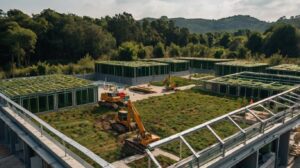Implementing more sustainable building technologies to the Philippines

The document titled “Implementing More Sustainable Building Technologies to the Philippines” by Gene Carlsson discusses the urgent need for adopting modern building technologies in the Philippines to address the challenges posed by rapid urbanization and climate change. It emphasizes the importance of transitioning from conventional construction methods to more sustainable practices that can enhance resilience and reduce environmental impacts.
Context and Challenges
The Philippines is experiencing significant urban growth, leading to increased housing demands and environmental degradation. As people flock to urban areas for better opportunities, the construction sector faces pressure to provide adequate housing while minimizing its carbon footprint. Traditional construction methods often rely heavily on concrete and steel, which contribute significantly to greenhouse gas emissions. The document argues that integrating sustainable building technologies is essential for mitigating these impacts and adapting to climate change.
Importance of Sustainable Technologies
Sustainable building technologies play a critical role in reducing energy consumption, lowering operational costs, and improving overall building performance. The document highlights several innovative technologies that can be adopted in the Philippines:
- Waffle Box House: Developed by a company called Silicon, this prefabricated structure reduces cement usage and carbon emissions while being resilient against natural disasters.
- Tunnel Form System: Imported from the UK by Phinma Properties, this technology allows for the rapid casting of entire walls and slabs in a single day, optimizing construction efficiency and reducing waste.
These examples illustrate how private companies are beginning to shift towards sustainable practices in response to market demands.
Barriers to Adoption
Despite the potential benefits of sustainable building technologies, several barriers hinder their widespread adoption in the Philippines:
- Financial Constraints: Many developers lack the capital necessary to invest in new technologies, as governmental agencies prioritize other pressing issues such as poverty and disaster response.
- Limited Awareness: There is a general lack of understanding among stakeholders about the advantages of sustainable building practices.
- Regulatory Challenges: Existing regulations may not support or incentivize the use of innovative materials and techniques.
Strategies for Implementation
To promote sustainable building technologies effectively, the document outlines several strategies:
1. Education and Training
Increasing awareness among architects, builders, and policymakers about sustainable practices is crucial. Training programs can equip stakeholders with the knowledge needed to implement modern building technologies effectively.
2. Financial Incentives
The government should consider providing financial support or incentives for developers who adopt sustainable practices. This could include tax breaks or grants aimed at reducing initial costs associated with new technologies.
3. Collaboration with Private Sector
Encouraging partnerships between government agencies and private companies can facilitate knowledge transfer and resource sharing. By leveraging private sector expertise, public projects can incorporate innovative solutions more effectively.
4. Regulatory Reforms
Updating building codes and regulations to include sustainability criteria will help create an environment conducive to adopting green technologies. This could involve establishing standards for energy efficiency and environmental impact assessments.
Recommendations for Architects
The document emphasizes that architects play a vital role in promoting sustainability through their design choices. Key recommendations include:
- Material Selection: Using biodegradable or recycled materials can significantly reduce environmental impact.
- Passive Design Strategies: Incorporating elements like passive cross-ventilation and cool roofs can enhance energy efficiency by leveraging natural resources.
- Flexible Design: Designing adaptable spaces allows buildings to meet changing needs over time without requiring extensive renovations.
Conclusion
In conclusion, the document asserts that implementing more sustainable building technologies in the Philippines is not only necessary for addressing environmental challenges but also presents economic opportunities for growth within the construction sector. By overcoming financial barriers, enhancing awareness, and fostering collaboration among stakeholders, the Philippines can transition towards a more sustainable built environment. The successful adoption of these strategies will lead to reduced greenhouse gas emissions, improved energy efficiency, and enhanced resilience against climate-related disasters. Ultimately, this shift will contribute positively to both local communities and global sustainability efforts, ensuring that future generations inherit a healthier planet.
